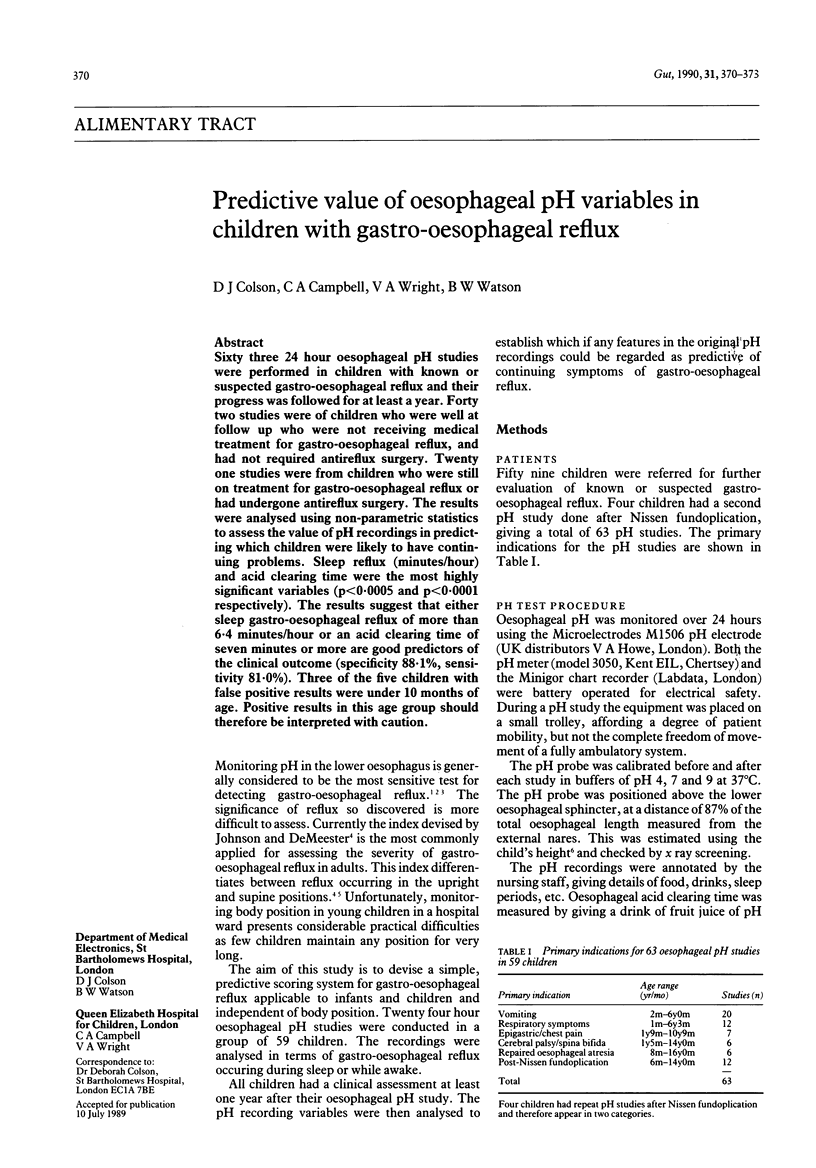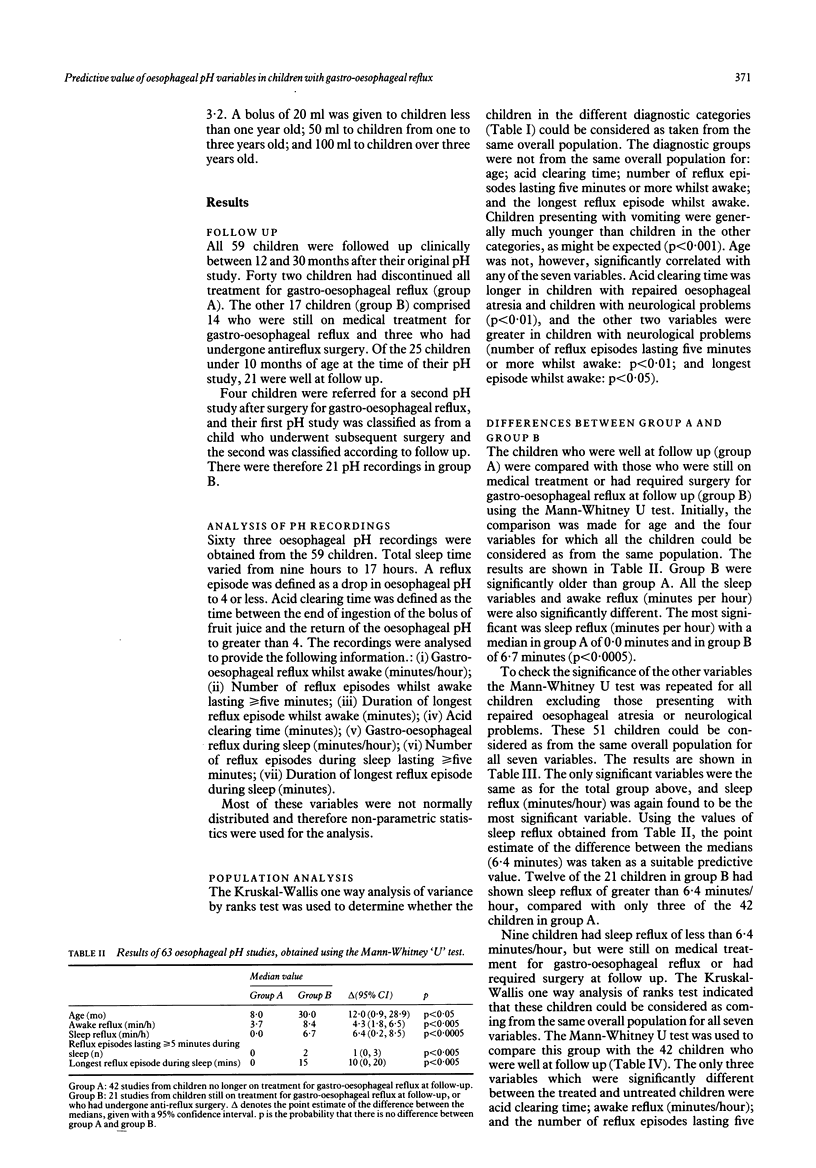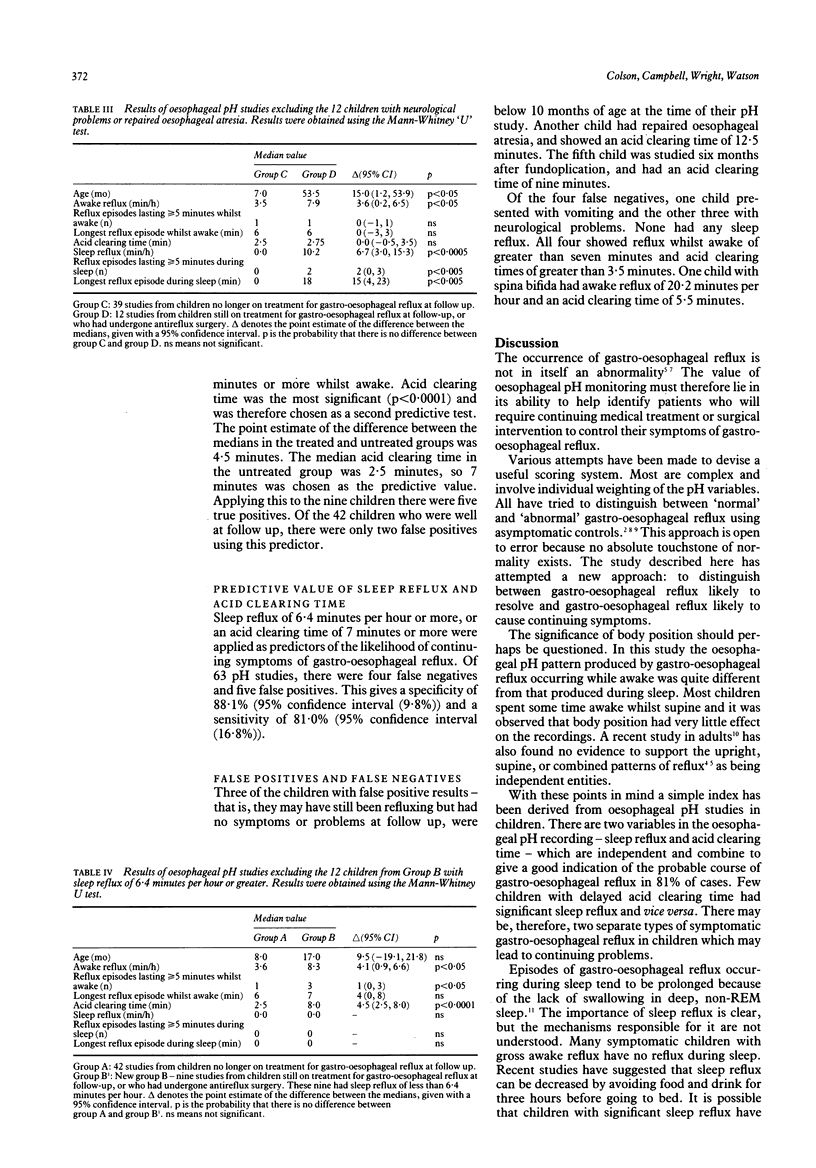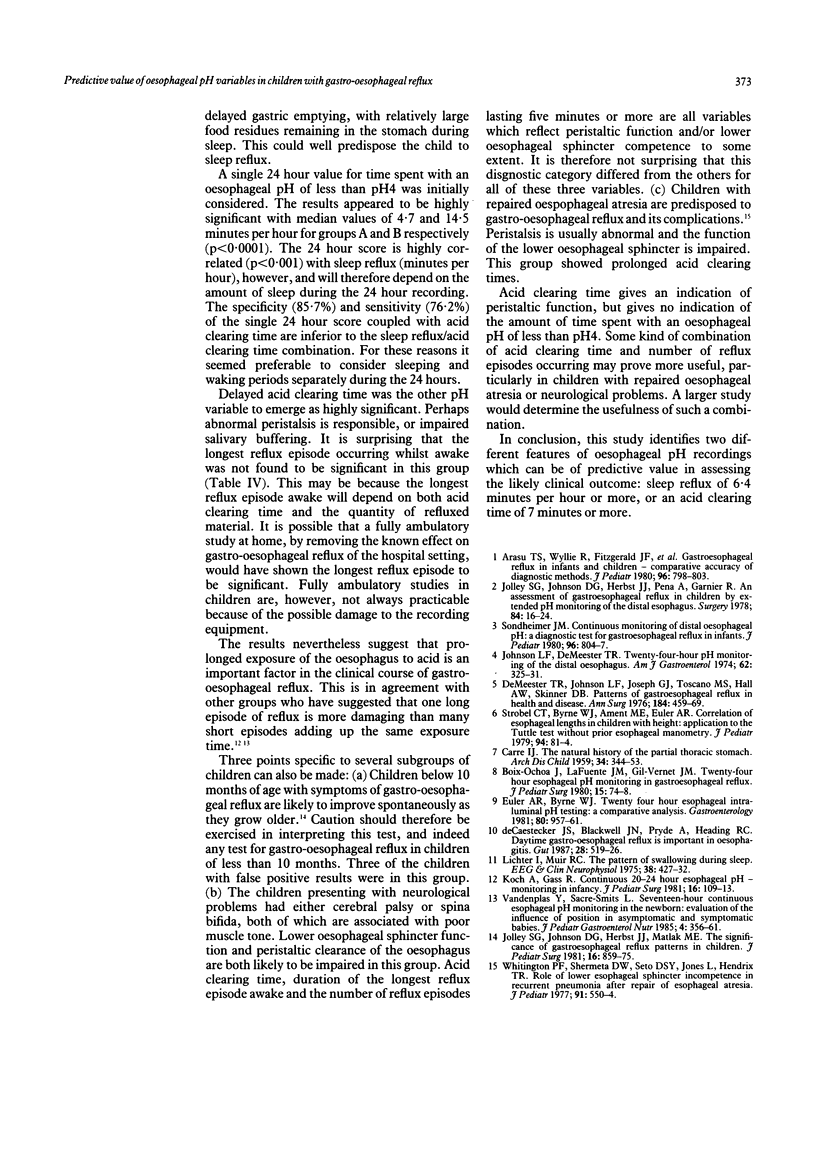Abstract
Sixty three 24 hour oesophageal pH studies were performed in children with known or suspected gastro-oesophageal reflux and their progress was followed for at least a year. Forty two studies were of children who were well at follow up who were not receiving medical treatment for gastro-oesophageal reflux, and had not required antireflux surgery. Twenty one studies were from children who were still on treatment for gastro-oesophageal reflux or had undergone antireflux surgery. The results were analysed using non-parametric statistics to assess the value of pH recordings in predicting which children were likely to have continuing problems. Sleep reflux (minutes/hour) and acid clearing time were the most highly significant variables (p less than 0.0005 and p less than 0.0001 respectively). The results suggest that either sleep gastro-oesophageal reflux of more than 6.4 minutes/hour or an acid clearing time of seven minutes or more are good predictors of the clinical outcome (specificity 88.1%, sensitivity 81.0%). Three of the five children with false positive results were under 10 months of age. Positive results in this age group should therefore be interpreted with caution.
Full text
PDF



Selected References
These references are in PubMed. This may not be the complete list of references from this article.
- Arasu T. S., Wyllie R., Fitzgerald J. F., Franken E. A., Siddiqui A. R., Lehman G. A., Eigen H., Grosfeld J. L. Gastroesophageal reflux in infants and children comparative accuracy of diagnostic methods. J Pediatr. 1980 May;96(5):798–803. doi: 10.1016/s0022-3476(80)80545-2. [DOI] [PubMed] [Google Scholar]
- CARRE I. J. The natural history of the partial thoracic stomach (hiatus hernia) in children. Arch Dis Child. 1959 Aug;34:344–353. doi: 10.1136/adc.34.176.344. [DOI] [PMC free article] [PubMed] [Google Scholar]
- Demeester T. R., Johnson L. F., Joseph G. J., Toscano M. S., Hall A. W., Skinner D. B. Patterns of gastroesophageal reflux in health and disease. Ann Surg. 1976 Oct;184(4):459–470. doi: 10.1097/00000658-197610000-00009. [DOI] [PMC free article] [PubMed] [Google Scholar]
- Euler A. R., Byrne W. J. Twenty-four-hour esophageal intraluminal pH probe testing: a comparative analysis. Gastroenterology. 1981 May;80(5 Pt 1):957–961. [PubMed] [Google Scholar]
- Johnson L. F., Demeester T. R. Twenty-four-hour pH monitoring of the distal esophagus. A quantitative measure of gastroesophageal reflux. Am J Gastroenterol. 1974 Oct;62(4):325–332. [PubMed] [Google Scholar]
- Jolley S. G., Johnson D. G., Herbst J. J., Matlak M. E. The significance of gastroesophageal reflux patterns in children. J Pediatr Surg. 1981 Dec;16(6):859–865. doi: 10.1016/s0022-3468(81)80835-4. [DOI] [PubMed] [Google Scholar]
- Jolley S. G., Johnson D. G., Herbst J. J., Pena A., Garnier R. An assessment of gastroesophageal reflux in children by extended pH monitoring of the distal esophagus. Surgery. 1978 Jul;84(1):16–24. [PubMed] [Google Scholar]
- Koch A., Gass R. Continuous 20-24 hr Esophageal pH-monitoring in infancy. J Pediatr Surg. 1981 Apr;16(2):109–113. doi: 10.1016/s0022-3468(81)80333-8. [DOI] [PubMed] [Google Scholar]
- Lichter I., Muir R. C. The pattern of swallowing during sleep. Electroencephalogr Clin Neurophysiol. 1975 Apr;38(4):427–432. doi: 10.1016/0013-4694(75)90267-9. [DOI] [PubMed] [Google Scholar]
- Sondheimer J. M. Continuous monitoring of distal esophageal pH: a diagnostic test for gastroesophageal reflux in infants. J Pediatr. 1980 May;96(5):804–807. doi: 10.1016/s0022-3476(80)80546-4. [DOI] [PubMed] [Google Scholar]
- Strobel C. T., Byrne W. J., Ament M. E., Euler A. R. Correlation of esophageal lengths in children with height: application to the Tuttle test without prior esophageal manometry. J Pediatr. 1979 Jan;94(1):81–84. doi: 10.1016/s0022-3476(79)80361-3. [DOI] [PubMed] [Google Scholar]
- Vandenplas Y., Sacre-Smits L. Seventeen-hour continuous esophageal pH monitoring in the newborn: evaluation of the influence of position in asymptomatic and symptomatic babies. J Pediatr Gastroenterol Nutr. 1985 Jun;4(3):356–361. doi: 10.1097/00005176-198506000-00006. [DOI] [PubMed] [Google Scholar]
- Whitington P. F., Shermeta D. W., Seto D. S., Jones L., Hendrix T. R. Role of lower esophageal sphincter incompetence in recurrent pneumonia after repair of esophageal atresia. J Pediatr. 1977 Oct;91(4):550–554. doi: 10.1016/s0022-3476(77)80500-3. [DOI] [PubMed] [Google Scholar]
- de Caestecker J. S., Blackwell J. N., Pryde A., Heading R. C. Daytime gastro-oesophageal reflux is important in oesophagitis. Gut. 1987 May;28(5):519–526. doi: 10.1136/gut.28.5.519. [DOI] [PMC free article] [PubMed] [Google Scholar]


